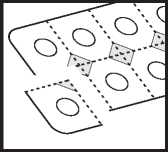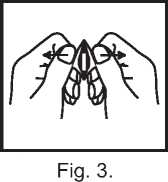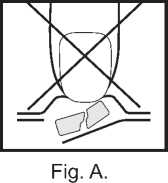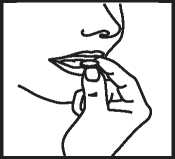Mirtazapine 15 Mg Orodispersible Tablets
Pharmacode position may change as per Supplier's m/c requirement &additional
small pharma code may appear on the front / back panel
J L
©
c
a
©
n_
5'
©

Fig. 1.

Package leaflet: Information for the patient
Mirtazapine 15 mg orodispersible tablets Mirtazapine 30 mg orodispersible tablets Mirtazapine 45 mg orodispersible tablets
(Mirtazapine)
Read all of this leaflet carefully before you start using this medicine because it contains important information for you.
• Keep this leaflet. You may need to read it again.
• If you have any further questions, ask your doctor or pharmacist.
• This medicine has been prescribed for you only. Do not pass it on to others. It may harm them, even if their signs of illness are the same as yours.
• If you get any side effects talk to your doctor or pharmacist. This includes any possible side effects not listed in this leaflet.
What is in this leaflet:
1. What Mirtazapine is and what it is used for
2. What you need to know before you take Mirtazapine
3. How to take Mirtazapine
4. Possible side effects
5. How to store Mirtazapine tablets
6. Contents of the pack and other information
1. What Mirtazapine is and what it is used for
Mirtazapine is one of a group of medicines called antidepressants. Mirtazapine is used to treat depressive illness in adults.
Mirtazapine will take 1 to 2 weeks before it starts working. After 2 to 4 weeks you may start feeling better. You must talk to your doctor if you do not feel better or if you feel worse after 2 to 4 weeks. More information is in section 3 heading "When can you expect to start feeling better".
2. What you need to know before you take Mirtazapine
Do not take Mirtazapine
• if you are allergic to mirtazapine or any of the other ingredients of his medicine (listed in section 6). If so, you must talk to your doctor as soon as you can before taking mirtazapine.
• if you are taking or have recently taken (within the last two weeks) medicines called monoamine oxidase inhibitors (MAO-Is).
Warnings and precautions
Talk to your doctor or pharmacist before taking Mirtazapine.
Use in children and adolescents under 18 years of age
Mirtazapine should normally not be used for children and adolescents under 18 years because efficacy was not demonstrated. Also, you should know that patients under 18 have an increased risk of side-effects such as suicide attempt, suicidal thoughts and hostility (predominantly aggression, oppositional behaviour and anger) when they take this class of medicines. Despite this, your doctor may prescribe Mirtazapine for patients under 18 because he/she decides that this is in their best interests. If your doctor has prescribed Mirtazapine for a patient under 18 and you want to discuss this, please go back to your doctor. You should inform your doctor if any of the symptoms listed above develop or worsen when patients under 18 are taking Mirtazapine. Also, the long-term safety effects concerning growth, maturation and cognitive and behavioural development of mirtazapine in this age group have not yet been demonstrated. In addition, significant weight gain has been observed in this age category more often when treated with Mirtazapine compared with adults.
Thoughts of suicide and worsening of your depression:
If you are depressed you can sometimes have thoughts of harming or killing yourself. These may be increased when first starting antidepressants, since these medicines all take time to work, usually about two weeks but sometimes longer.
You may be more likely to think like this:
• If you have previously had thoughts about killing or harming yourself.
• If you are a young adult. Information from clinical trials has shown an increased risk of suicidal behaviour in adults aged less than 25 years with psychiatric conditions who were treated with an antidepressant.
" Ifyouhave thoughts of harming or killing yourself at any time, contact your doctor or go to a hospital straight away.
You may find it helpful to tell a relative or close friend that you are depressed, and ask them to read this leaflet. You might ask them to tell you if they think your depression is getting worse, or if they are worried about changes in your behaviour.
Also take special care with mirtazapine
• if you have, or have ever had one of the following conditions.
" Tell your doctor about these conditions before taking mirtazapine, if not done previously.
- seizures (epilepsy). If you develop seizures or your seizures become more frequent, stop taking mirtazapine and contact your doctor immediately;
- liver disease, including jaundice. If jaundice occurs, stop taking mirtazapine and contact your doctor immediately;
- kidney disease;
- heart disease, or low blood pressure;
- schizophrenia. If psychotic symptoms, such as paranoid thoughts become more frequent or severe, contact your doctor straight away;
- manic depression (alternating periods of feeling elated/overactivity and depressed mood). If you start feeling elated or over-excited, stop taking mirtazapine and contact your doctor immediately;
- diabetes (you may need to adjust your dose of insulin or other antidiabetic medicines);
- eye disease, such as increased pressure in the eye (glaucoma);
- difficulty in passing water (urinating), which might be caused by an enlarged prostate.
• if you develop signs of infection such as inexplicable high fever, sore throat and mouth ulcers.
" Stop taking mirtazapine and consult your doctor immediately for a blood test. In rare cases these symptoms can be signs of disturbances in blood cell production in the bone marrow. While rare, these symptoms most commonly appear after 4-6 weeks of treatment.
• if you are an elderly person. You could be more sensitive to the side-effects of antidepressants.
Other medicines and Mirtazapine
Tell your doctor or pharmacist if you are taking, have recently taken or might take any other medicines.
Do not take mirtazapine in combination with:
• monoamine oxidase inhibitors (MAO inhibitors). Also, do not take mirtazapine during the two weeks after you have stopped taking MAO inhibitors. If you stop taking mirtazapine, do not take MAO inhibitors during the next two weeks either. Examples of MAO inhibitors are moclobemide, tranylcypromine (both are antidepressants) and selegiline (used for Parkinson’s disease).
Take care when taking mirtazapine in combination with:
• antidepressants such as SSRIs, venlafaxine and L-tryptophan, or triptans (used to treat migraine), tramadol (a pain-killer), linezolid (an antibiotic), lithium (used to treat some psychiatric conditions) and St. John’s Wort - Hypericum perforatum preparations (a herbal remedy for depression). In very rare cases mirtazapine alone or the combination of mirtazapine with these medicines, can lead to a so-called serotonin syndrome. Some of the symptoms of this syndrome are: inexplicable fever, sweating, increased heart rate, diarrhoea, (uncontrollable) muscle contractions, shivering, overactive reflexes, restlessness, mood changes, and unconsciousness. If you get a combination of these symptoms, talk to your doctor immediately.
• the antidepressant nefazodone. It can increase the amount of mirtazapine in your blood. Inform your doctor if you are using this medicine. It might be needed to lower the dose of mirtazapine, or when use of nefazodone is stopped, to increase the dose of mirtazapine again.
• medicines for anxiety or insomnia such as benzodiazepines. medicines for schizophrenia such as olanzapine; medicines for allergies such as cetirizine;
medicines for severe pain such as morphine.
In combination with these medicines mirtazapine can increase the drowsiness caused by these medicines.
• medicines for infections; medicines for bacterial infections (such as erythromycin); medicines for fungal infections (such as ketoconazole) and medicines for HIV/AIDS (such as HIVprotease inhibitors) and drugs for stomach ulcers (such as cimetidine).. In combination with mirtazapine these medicines can increase the amount of mirtazapine in your blood. Inform your doctor if you are using these medicines. It might be needed to lower the dose of mirtazapine, or when these medicines are stopped, to increase the dose of mirtazapine again.
• medicines for epilepsy such as carbamazepine and phenytoin; medicines for tuberculosis such as rifampicin.
In combination with mirtazapine these medicines can reduce the amount of mirtazapine in your blood. Inform your doctor if you are using these medicines. It might be needed to increase the dose of mirtazapine, or when these medicines are stopped to lower the dose of mirtazapine again.
• medicines to prevent blood clotting such as warfarin.
Mirtazapine can increase the effects of warfarin on the blood. Inform your doctor if you are using this medicine. In case of combination it is advised that a doctor monitors your blood carefully.
Mirtazapine with food, drink and alcohol
You may get drowsy if you drink alcohol while taking mirtazapine.
You are advised not to drink any alcohol.
You can take mirtazapine with or without food.
Pregnancy, breast-feeding and fertility
If you are pregnant or breast-feeding, think you may be pregnant or are planning to have a baby, ask your doctor or pharmacist for advice before taking this medicine.
Limited experience with mirtazapine administration to pregnant women does not indicate an increased risk. However, caution should be exercised when used during pregnancy.
If you use mirtazapine until, or shortly before birth, your baby should be supervised for possible adverse effects.
Make sure your midwife and/or doctor knows you are on Mirtazapine. When taken during pregnancy, similar drugs (SSRIs) may increase the risk of a serious condition in babies, called persistent pulmonary hypertension of the newborn (PPHN), making the baby breathe faster and appear bluish. These symptoms usually begin during the first 24 hours after the baby is born. If this happens to your baby you should contact your midwife and/or doctor immediately.
Driving and using machines
Mirtazapine can affect your concentration or alertness. Make sure these abilities are not affected before you drive or operate machinery. If your doctor has prescribed Mirtazapine for a patient under 18 years make sure the concentration and alertness is not affected before participation in traffic (e.g. on bicycle).
Mirtazapine tablets contains aspartame, a source of phenylalanine. May be harmful for people with phenylketonuria.
3. How to take Mirtazapine
Always take this medicine exactly as your doctor or pharmacist has told you. Check with your doctor or pharmacist if you are not sure.
How much to take
The recommended starting dose is 15 or 30 mg every day. Your doctor may advise you to increase your dose after a few days to the amount that is best for you (between 15 and 45 mg per day). The dose is usually the same for all ages. However, if you are an elderly person or if you have renal or liver disease, your doctor may adapt the dose.
When to take mirtazapine
" Take mirtazapine at the same time each day.
It is best to take mirtazapine as a single dose before you go to bed. However your doctor may suggest to split your dose of mirtazapine - once in the morning and once at night-time before you go to bed. The higher dose should be taken before you go to bed.
Take the orodispersible tablet as follows:
Take your tablets orally.
1. Do not crush the orodispersibl 2. Tear off one tablet pocket tablet Each strip contains six tablet pockets,
In order to prevent crushmg to which are separated by perforations.
orodispersible tablet, do not pus Tear off one tablet pocket along the
against the tablet pocket (Figure A) dotted lines (Figure 1).

3. Peel off the lid
Carefully peel off the lidding foil, starting in the corner indicated by the arrow (Figures 2 and 3).

4. Take out the orodispersible tablet
Take out the orodispersible tablet with dry hands and place it on the tongue (Figure 4).

Fig. 4.
It will rapidly disintegrate and can be swallowed without water.
Black
Belgium:
Bulgaria:
Cyprus:
Denmark:
Estonia:
Finland:
France:
Germany:
Greece:
Hungary:
Ireland:
Italy:
Latvia:
Lithuania:
Netherlands:
Poland:
Portugal:
Romania:
Spain:
Sweden:
United Kingdom:
When can you expect to start feeling better
Usually mirtazapine will start working after 1 to 2 weeks and after 2 to 4 weeks you may start to feel better.
It is important that, during the first few weeks of the treatment, you talk with your doctor about the effects of mirtazapine:
" 2 to 4 weeks after you have started taking mirtazapine, talk to your doctor about how
this medicine has affected you.
If you still don' t feel better, your doctor may prescribe a higher dose. In that case, talk to your doctor again after another 2 to 4 weeks. Usually you will need to take mirtazapine until your symptoms of depression have disappeared for 4 to 6 months.
If you take more mirtazapine than you should
If you or someone else have taken too much mirtazapine, call a doctor straight away.
The most likely signs of an overdose of mirtazapine (without other medicines or alcohol) are drowsiness, disorientation and increased heart rate.
If you forget to take Mirtazapine
If you are supposed to take your dose once a day
• Do not take a double dose to make up for a forgotten dose. Take your next dose at the normal time.
If you are supposed to take your dose twice a day
• If you have forgotten to take your morning dose, simply take it together with your evening dose.
• If you have forgotten to take your evening dose, do not take it with the next morning dose; just skip it and continue with your normal morning and evening doses.
• If you have forgotten to take both doses, do not attempt to make up for the missed doses. Skip both doses and continue the next day with your normal morning and evening doses.
If you stop taking mirtazapine
" Only stop taking mirtazapine in consultation with your doctor.
If you stop too early, your depression might come back. Once you are feeling better, talk to your doctor. Your doctor will decide when treatment can be stopped. Do not suddenly stop taking mirtazapine, even when your depression has lifted.
If you suddenly stop taking mirtazapine you may feel sick, dizzy, agitated or anxious, and have headaches. These symptoms can be avoided by stopping gradually. Your doctor will tell you how to decrease the dose gradually.
If you have any further questions on the use of this medicine, ask your doctor or pharmacist.
Possible side effects
Like all medicines, this medicine can cause side effects, although not everybody gets these side effects.
If you experience any of the following serious side effects, stop taking mirtazapine and tell your doctor immediately.
Uncommon (may affect up to 1 in 100 people):
• feeling elated or emotionally ‘high’ (mania)
Rare (may affect up to 1 in 1,000 people):
• yellow colouring of eyes or skin; this may suggest disturbance in liver function (jaundice)
Not known (frequency cannot be estimated from the available data):
• signs of infection such as sudden unexplainable high fever, sore throat and mouth ulcers (agranulocytosis). In rare cases mirtazapine can cause disturbances in the production of blood cells (bone marrow depression). Some people become less resistant to infection because mirtazapine can cause a temporary shortage of white blood cells (granulocytopenia). In rare cases mirtazapine can also cause a shortage of red and white blood cells, as well as blood platelets (aplastic anemia), a shortage of blood platelets (thrombocytopenia) or an increase in the number of white blood cells (eosinophilia).
• epileptic attack (convulsions)
• a combination of symptoms such as inexplicable fever, sweating, increased heart rate, diarrhoea, (uncontrollable) muscle contractions, shivering, overactive reflexes, restlessness, mood changes, unconsciousness and increased salivation. In very rare cases these can be signs of serotonin syndrome.
• thoughts of harming or killing yourself
• severe skin reactions (Stevens-Johnson Syndrome, toxic epidermal necrolysis)
Very common (may affect more than 1 in 10 people):
• increase in appetite and weight gain
• drowsiness or sleepiness
• headache
• dry mouth
Common (may affect up to 1 in 10 people:
• lethargy
• dizziness
• shakiness or tremor
• nausea
• diarrhoea
• vomiting
• rash or skin eruptions (exanthema)
• pain in your joints (arthralgia) or muscles (myalgia)
• back pain
• feeling dizzy or faint when you stand up suddenly (orthostatic hypotension)
• swelling (typically in ankles or feet) caused by fluid retention (oedema)
• tiredness
• vivid dreams
• confusion
• feeling anxious
• sleeping problems
Uncommon (may affect up to 1 in 100 people)::
• abnormal sensation in the skin e.g. burning, stinging, tickling or tingling (paraesthesia)
• restless legs
• fainting (syncope)
• sensations of numbness in the mouth (oral hypoaesthesia)
• low blood pressure
• nightmares
• feeling agitated
• hallucinations
• urge to move
Rare (may affect up to 1 in 1,000 people)
• muscle twitching or contractions (myoclonus)
• aggression
• pancreatitis
Not known (frequency cannot be estimated from the available data):
• abnormal sensations in the mouth (oral paraesthesia)
• swelling in the mouth (mouth oedema)
• swelling throughout the body (generalized oedema)
• localized swelling
• hyponatraemia
• inappropriate anti-diuretic hormone secretion
• sleepwalking(somnambulism)
• severe skin reactions (dermatitis bullous, erythema multiforme )
• speech disorder
Reporting of side effects
If you get any side effects, talk to your doctor or pharmacist or nurse. This includes any possible side effects not listed in this leaflet.
Also you can help to make sure that medicines remain as safe as possible by reporting any unwanted side effects via the internet at www.mhra.gov.uk/yellowcard. Alternatively you can call Freephone 0808 100 3352 (available from 10 a.m. to 2 p.m. Mondays to Fridays) or fill in a paper form available from your local pharmacy.
5. How to store Mirtazapine
Keep this medicine out of the sight and reach of children.
Do not use this medicine after the expiry date which is stated on the carton and blister after EXP. The expiry date refers to the last day of that month.
This medicinal product does not require any special storage conditions.
Do not throw away any medicines via wastewater or household waste. Ask your pharmacist how to throw away medicines no longer used. These measures will help to protect the environment.
6. Contents of the pack and other information
What Mirtazapine contains
• The active substance is mirtazapine. Each orodispersible tablet contains 15 mg, 30 mg or 45 mg mirtazapine.
• The other ingredients are crospovidone (type B), mannitol (E421), Cellulose, microcrystalline, aspartame (E951), silica colloidal anhydrous, magnesium stearate, strawberry guarana flavor [maltodextrin, propylene glycol, artificial flavours, acetic acid] and peppermint flavor [artificial flavours, corn starch].
What Mirtazapine look like and contents of the pack
Orodispersible tablet.
Mirtazapine 15 mg orodispersible tablets:
White, round (diameter 6.5 mm) orodispersible tablets debossed with “36”on one side and ‘A’ on the other side with an embossed circular edge.
Mirtazapine 30 mg orodispersible tablets:
White, round (diameter 8.0 mm) orodispersible tablets debossed with “37” on one side and ‘A’ on the other side with an embossed circular edge.
Mirtazapine 45 mg orodispersible tablets:
White, round (diameter 9.5 mm) orodispersible tablets debossed with “38” on one side and ‘A’ on the other side with an embossed circular edge.
Mirtazapine orodispersible tablets are available in Polyamide/ aluminium/ PVC/ paper/ polyster/ aluminum perforated unit dose blister packs of 6, 18, 30, 48, 90 and 96 tablets.
Not all pack sizes may be marketed.
Marketing Authorization Holder
Aurobindo Pharma Limited Ares, Odyssey Business Park West End Road South Ruislip HA4 6QD United Kingdom Tel: ++ 44 20 8845 8811 Fax: ++ 44 20 8845 8795
Manufacturer
Milpharm Limited Ares, Odyssey Business Park West End Road South Ruislip HA4 6QD United Kingdom
or
APL Swift Services (Malta) Limited HF26, Hal Far Industrial Estate, Hal Far Birzebbugia, BBG 3000 Malta or
Pfizer Service Company BVBA Hoge Wei 10
B-1930 Zaventem, Belgium or
LABORATORIOS CINFA, S.A. Ctra. Olaz-Chipi 10, Pol. Ind. Areta 31620 Huarte-Pamplona (Navarra) Spain
This medicinal product is authorized in the Member States of the EEA under the following names:
Mirtazapine Apotex® 15 mg/ 30 mg/ 45 mg orodispergeerbare tabletten Mirtazapine Aurobindo 15 mg/ 30 mg/ 45 mg TaSne™, gMcneprnpa^a ce b ycTaTa
Mirtazapin Aurobindo 15 mg/ 30 mg/ 45 mg 5iawa 5iaan£ip6ji£vo ara 0T6jia
Mirtazapin “Aurobindo”
Mirtazapin Aurobindo 15 mg/ 30 mg/ 45 mg suus dispergeeruvad tabletid
Mirtazapin Aurobindo 15 mg/ 30 mg/ 45 mg tabletti, suussa hajoava MIRTAZAPINE ARROW 15 mg, comprimes orodispersible Mirtazapin Aurobindo 15 mg/ 30 mg/ 45 mg Schmelztabletten mirtazaFer 15 mg/ 30 mg/ 45 mg 5iaKa 5iaan£ip6ji£vo ara 0T6ja Mirtazapine Aurobindo 30 mg/ 45 mg szajban diszpergalodo tabletta Mirtazapine Aurobindo 15 mg/ 30 mg/ 45 mg orodispersible tablets MIRTAZAPINA DOC Generici 15 mg/ 30 mg/ 45 mg compresse orodispersibili
Mirtazapin Aurobindo 15 mg/ 30 mg/ 45 mg mute dispergejamas tabletes
Mirtazapin Aurobindo 15 mg/ 30 mg/ 45 mg burnoje disperguojamosios tabletes
Mirtazapine Aurobindo 15mg/30mg/45mg orodispergeerbare tabletten Mirtazapine Aurobindo Mirtazapina Aurobindo
Mirtazapin Aurobindo 15 mg/ 30 mg/ 45 mg comprimate orodispersabile MIRTAZAPINA FLAS CINFA 15 mg/ 30 mg/ 45 mg comprimidos bucodispersables
Mirtazapin Aurobindo 15 mg/ 30 mg/ 45 mg munsonderfallande tabletter Mirtazapine 15 mg/ 30 mg/ 45 mg orodispersible tablets
This leaflet was last revised in 01/2015.
P150
L
Additional side effects in children and adolescents
In children under 18 years the following adverse events were observed commonly in clinical trials: significant weight gain, hives and increased blood triglycerides.